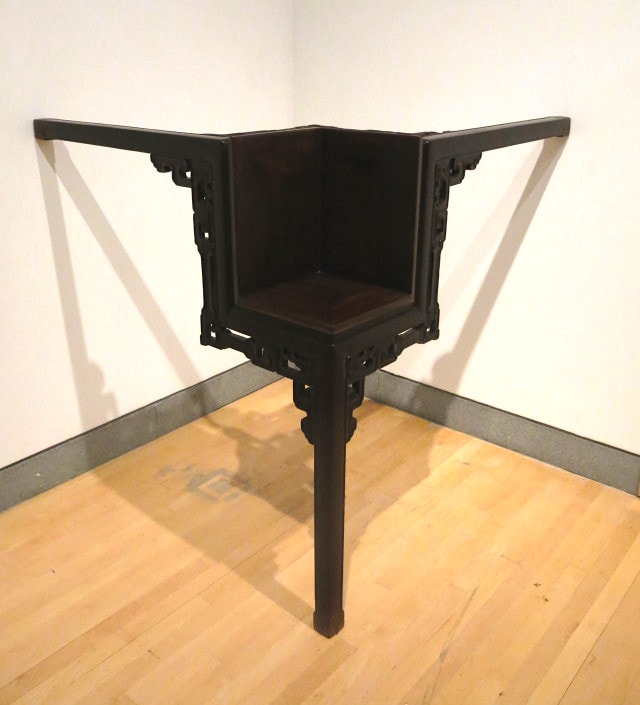Ai Weiwei is an artist.
Born in 1957, he currently resides and works in Beijing.
_________
This innocuous biography is all that is listed on the artist’s website, along with a simple link to a Wikipedia biography; however even the information on the 28 page Wikipedia does not fully describe the complex personal history and passions of this remarkable man and artist.
Based on a couple of intriguing images and equipped with only a bit of knowledge about this artist I made plans to go to the Brooklyn Museum to see:
Ai Weiwei: According to What?
I was prepared for a show that was politically provocative, but I was NOT prepared for the incredible beauty – the intellectually and emotionally rich experience that lay ahead.
Floor: ‘Straight’, 2008–12. Steel reinforcing bars, dimensions variable
Back wall: ‘Names of the Student Earthquake Victims Found by the Citizens’ Investigation’, 2009-11
.
The installation at the Brooklyn Museum is spectacular in all of its elegance, restraint, beautiful lighting, pacing and spacing, and the skillful multi-dimensional and extra-sensory configuration.
The exhibition appears to have aesthetic roots in Minimalism, but upon closer inspection and consideration rich, often social or political content lies just under the surface.
‘Bowls of Pearls’, 2006 , porcelain bowls and freshwater pearls
.
As a contemporary artist Ai Weiwei knows no bounds as evidenced by his work in a multitude of mediums: architecture, sculpture, film, photography, installation, curation, and embracing the internet and social media as a platform for his activism.
He is one of China’s most most prolific and provocative contemporary artists who has become an enormous thorn in the side of the ruling Communist Party of China.
Foreground: ‘Colored Vases’, 2007‒10, Han Dynasty vases and industrial paint
Back: ‘Dropping a Han Dynasty Urn’, 1995-2009, Triptych: Lambda Prints-75-3/8″ x 70-7/8″ ea
.
Ai Weiwei’s father was a poet who for many years was on the wrong side of the state policies under Mao Zedong, and for the majority of his first 16 years Ai and his family lived in exile – most certainly having an effect on a bright mind.
After the death of Mao and the beginning of the Cultural Revolution in China, Ai and his family moved back to Beijing, allowing him to find ways for his artistic voice to be heard.
1981-1993 was a very important chapter of Ai Weiwei’s development as a man and an artist: He spent these years studying, looking, shooting lots of photographs and participating in the downtown art world in New York City.
Writers often site Marcel Duchamp, Andy Warhol, and Jasper Johns as influences leading to his creating conceptual artworks by altering ready-made objects. I would suggest that he was also swayed by sculptural works by Donald Judd, Felix Gonzales-Torres, Joel Shapiro, Walter de Maria (see previous blog post), Sol LeWitt, as well as the work of other conceptual artists.
Wherever his ideas came from, I am impressed with how masterfully he has made the works a reflection of his own life as a contemporary Chinese artist, with his work remaining simultaneously readable as ‘universal’.
After doing more and more research on Ai Weiwei – seeing how the content threads go off in many directions – he becomes all the more difficult to talk about: I now understand why the biography on his website is so simple.
.
S.A.C.R.E.D, a six-part work composed of (i) S upper, (ii) A ccusers, (iii) C leansing, (iv) R itual, (v) E ntropy, (iv) D oubt, 2011‒13.
.
‘Moon Chest’, 2008, 7 chests in Huali wood, 126″ x 63″ x 31-1/2″ ea
Corner Table, 2007, Qing Dynasty wood, 2007, 43 3/10 × 43 3/10 × 43 3/10
.
The more you consider the artist Ai Weiwei, the more you find yourself facing fundamental questions concerning human existence – related questions that underlie Ai’s richly varied creative activities.
.
“Truly a ‘Renaissance Man’ Ai works not only in the visual arts, but also in the fields of architecture, design, publishing, and exhibition planning; and in addition (often with the aid of technology) his activities have become more overtly connected with the events of politics, society, and everyday life, and now reach a wider public.”
-Mami Kataoka “A Questioning Attitude”from the exhibition catalog for “According to What”
.
I see Ai Weiwei as a vessel of cultural conscience for people everywhere. He speaks up for what he thinks is just and fair and right. Ai Weiwei: According to What? features over forty works spanning more than twenty years, exploring universal topics of culture, history, politics, and tradition. The works spotlight issues of freedom of expression, as well as individual and human rights both in China and globally.
The exhibition took my breath away – many times. I can confidently say that it is one of the most beautiful, impactful, and inspiring museum shows that I have seen in many, many years and recommend that you too venture out to the Brooklyn Museum to discover Ai Weiwei for yourself.
.
Ai Weiwei: According to What?
April 18–August 10, 2014
200 Eastern Parkway
To dig deeper into the world of Ai Weiwei watch this recent interview from the BBC, and follow the links below it to learn more.
.
.







